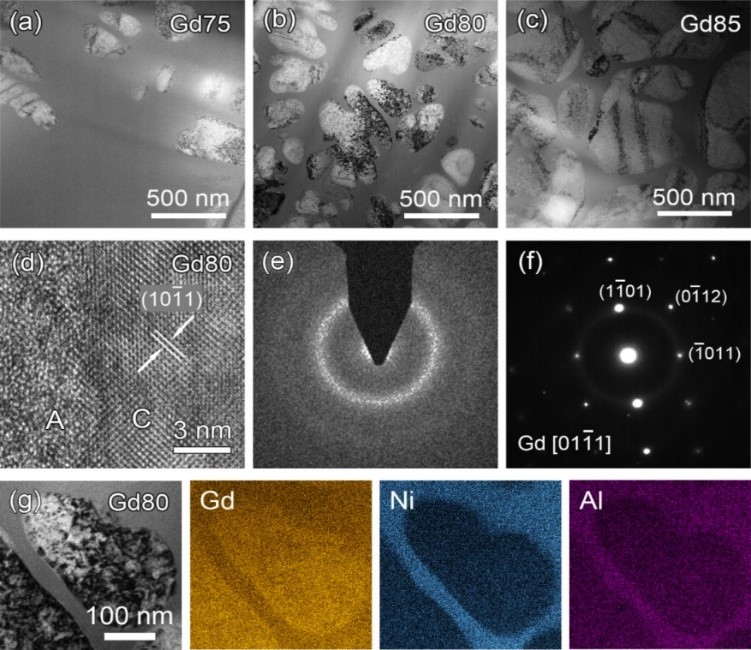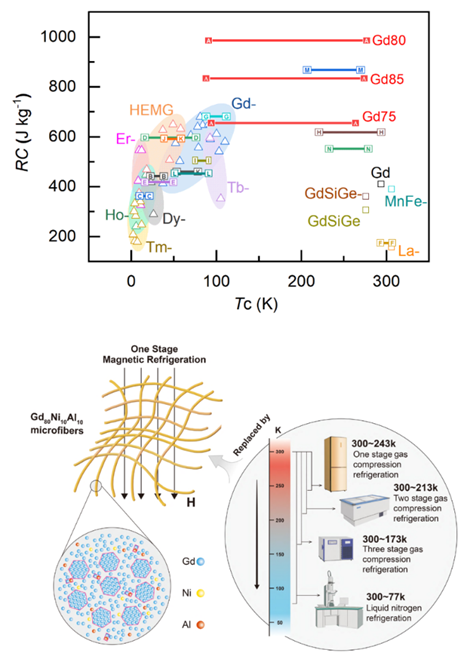Compared with the conventional gas compression refrigeration, magnetic refrigeration (MR) based on the magnetocaloric effect (MCE) attracted growing attention due to its some advantages, e.g., high efficiency, low noise, compactness and environmental friendliness. The MR has been considered as the next-generation refrigeration technology. Exploring the new MCE materials with high performance is the hotspot in the research area of MR. Attributed to the disordered structure, the MCE amorphous alloys possess the wide working temperature span, high strength and corrosion resistance compared with MCE crystalline alloys. Therefore, the MCE amorphous alloys own a great potential application.
A series of new MCE amorphous alloys and their microstructure have been studied by our Non-crystalline Functional Materials Group, Ningbo Institute of Materials Technology and Engineering, Chinese Academy of Sciences. By inducing the configurational entropy into the amorphous alloys, we explored a series of high-entropy metallic-glasses with the excellent MCE properties. The highest value of maximum magnetic entropy change is up to 15 J kg-1 K-1. Meanwhile, the high-entropy metallic-glasses possess wide working temperature span (116 K), which is attributed to their spin glass phase and complex structure. These leads to the large cooling efficiency of 691 J kg-1 【Intermetallics 2015 (58) 31-35; J. Appl. Phys. 2015 (117) 073902; J. Alloys Compd. 2019 (776) 202-206】. Our group prepared the high-entropy metallic-glasses into microwire form using melt-extraction equipment. The high surface-to-volume ratio of the microwire satisfies the demand for high heat-exchange efficiency of practical MR 【Intermetallics 2018 (96) 79-83】. In addition, by optimizing the compositions and microstructure, we explored a series of amorphous alloys with high MCE performance and Curie temperatures around room temperatures. We systematical investigate the effects of composition, microstructure and magnetic structure on the MCE properties of these alloys 【Metals 2021 (11) 950; J. Alloys Compd. 2020 (845) 156191; J. Alloys Compd. 2016 (684) 29-33; J Non-Crystl. Solids 2015 (425) 114-117; J. Magn. Magn. Mater. 2018 (446) 162-165; J. Magn. Magn. Mater. 2019 (489) 165404; J. Magn. Magn. Mater. 2019 (475) 249-256】.
Recently, we prepared a series of Gd-based amorphous/nanocrystalline composite microwires by using melt-extraction technology. These microwires simultaneously exhibit the advantages of Gd-based amorphous phase and nanocrystalline phase. The size, content and distribution of the nanocrystalline phase are tuned by optimizing the composition of the composites and controlling the processing parameters. This leads to the enhanced MCE properties. These composite microwires exhibit the comparable magnetic entropy change from 70 K to near room temperature. Their highest cooling efficiency is up to 985 J kg-1, which is higher than that of the reported crystalline and amorphous MCE materials. The corresponding paper entitled by “Giant refrigerant capacity in Gd-based amorphous/ nanocrystalline composite fibers” is published on Materials Today Physics 21 (2021) 100528.


Fig.1 The microstructure and magnetocaloric properties of Gd-based amorphous/nanocrystalline composites.
The above research work has been supported by the projects of the National Key R&D Program of China (2018YFA0703602, 2018YFA0703604), National Natural Science Foundation of China (51771217, 51827801, 51922102), and the Youth Innovation Promotion Association of the Chinese Academy of Sciences (2019296).

